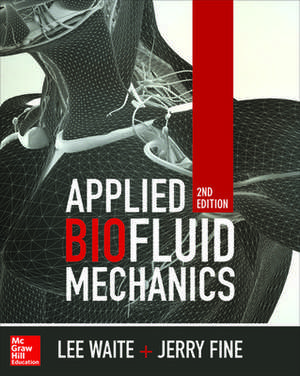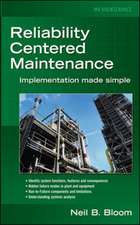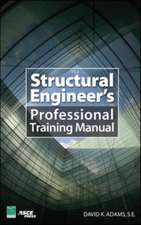Applied Biofluid Mechanics, Second Edition
Autor Lee Waite, Jerry Fineen Limba Engleză Hardback – 18 aug 2017
Up-To-Date Coverage of Biofluid Mechanics and Applications in Medical Devices
This thoroughly revised textbook shows how fluid mechanics works in the human circulatory system and offers cutting-edge applications in the development and design of medical instruments, equipment, and procedures. Applied Biofluid Mechanics, Second Edition, examines cardiovascular anatomy and physiology, hematology, blood vessel histology and function, heart valve mechanics and prosthetic valves, stents, pulsatile flow in large arteries, measurements, dimensional analysis, and more. This edition contains updated information on pulsatile flow modeling and a brand-new chapter that explains renal biofluids. The book also features online materials for both students and instructors, including a solutions manual.
• Review of biofluid mechanics concepts
• Cardiovascular structure and function
• Pulmonary anatomy and physiology and respiration
• Hematology and blood rheology
• Anatomy and physiology of blood vessels
• Mechanics of heart valves
• Pulsatile flow in large arteries
• Flow and pressure measurement
• Modeling
• Lumped parameter mathematical models
• Renal biofluids
Preț: 831.75 lei
Preț vechi: 1215.98 lei
-32% Nou
Puncte Express: 1248
Preț estimativ în valută:
159.17€ • 165.24$ • 132.73£
159.17€ • 165.24$ • 132.73£
Carte tipărită la comandă
Livrare economică 21 martie-01 aprilie
Preluare comenzi: 021 569.72.76
Specificații
ISBN-13: 9781259644153
ISBN-10: 1259644154
Pagini: 352
Dimensiuni: 152 x 236 x 23 mm
Greutate: 0.64 kg
Ediția:2
Editura: McGraw Hill Education
Colecția McGraw-Hill
Locul publicării:United States
ISBN-10: 1259644154
Pagini: 352
Dimensiuni: 152 x 236 x 23 mm
Greutate: 0.64 kg
Ediția:2
Editura: McGraw Hill Education
Colecția McGraw-Hill
Locul publicării:United States
Cuprins
1 Review of Basic Fluid Mechanics Concepts
1.1 A Brief History of Biomedical Fluid Mechanics
1.2 Fluid Characteristics and Viscosity
1.2.1 Displacement and Velocity
1.2.2 Shear Stress and Viscosity
1.2.3 Example Problem: Shear Stress
1.2.4 Viscosity
1.2.5 Clinical Feature: Polycythemia
1.3 Fundamental Method for Measuring Viscosity
1.3.1 Example Problem: Viscosity Measurement
1.4 Introduction to Pipe Flow
1.4.1 Reynolds Number
1.4.2 Example Problem: Reynolds Number
1.4.3 Poiseuille’s Law
1.4.4 Flow Rate
1.5 Bernoulli Equation
1.6 Conservation of Mass
1.6.1 Venturi Meter Example
1.7 Fluid Statics
1.7.1 Example Problem: Fluid Statics
1.8 The Womersley Number α—A Frequency Parameter for Pulsatile Flow
1.8.1 Example Problem: Womersley Number
Review Problems
Bibliography
2 Cardiovascular Structure and Function
2.1 Introduction
2.2 Clinical Features
2.3 Functional Anatomy
2.4 The Heart as a Pump
2.5 Cardiac Muscle
2.5.1 Biopotential in Myocardium
2.5.2 Excitability
2.5.3 Automaticity
2.6 Electrocardiograms
2.6.1 Electrocardiogram Leads
2.6.2 Mean Electrical Axis
2.6.3 Example Problem: Mean Electrical Axis
2.6.4 Unipolar versus Bipolar and Augmented Leads
2.6.5 Electrocardiogram Interpretations
2.6.6 Clinical Feature: Near Maximal Exercise Stress Test
2.7 Heart Valves
2.7.1 Clinical Features
2.8 Cardiac Cycle
2.8.1 Pressure–Volume Diagrams
2.8.2 Changes in Contractility
2.8.3 Ventricular Performance
2.8.4 Cardiac Output (CO) Curves and Cardiac Function Curves
2.8.5 Clinical Feature: Congestive Heart Failure
2.8.6 Pulsatility Index
2.8.7 Example Problem: Pulsatility Index
2.9 Heart Sounds
2.9.1 Clinical Features
2.9.2 Factors Influencing Flow and Pressure
2.10 Coronary Circulation
2.10.1 Control of Coronary Circulation
2.10.2 Clinical Features
2.11 Microcirculation
2.11.1 Capillary Structure
2.11.2 Capillary Wall Structure
2.11.3 Pressure Control in Microvasculature
2.11.4 Diffusion in Capillaries
2.11.5 Venules
2.12 Lymphatic Circulation
Review Problems
Bibliography
3 Pulmonary Anatomy, Pulmonary Physiology, and Respiration
3.1 Introduction
3.1.1 Clinical Features: Hyperventilation
3.2 Alveolar Ventilation
3.2.1 Tidal Volume
3.2.2 Residual Volume
3.2.3 Expiratory Reserve Volume
3.2.4 Inspiratory Reserve Volume
3.2.5 Functional Residual Capacity
3.2.6 Inspiratory Capacity
3.2.7 Total Lung Capacity
3.2.8 Vital Capacity
3.3 Ventilation-Perfusion Relationships
3.4 Mechanics of Breathing
3.4.1 Muscles of Inspiration
3.4.2 Muscles of Expiration
3.4.3 Compliance of the Lung and Chest Wall
3.4.4 Elasticity, Elastance, and Elastic Recoil
3.4.5 Example Problem: Compliance
3.5 Work of Breathing
3.5.1 Clinical Features—Respiratory Failure
3.6 Airway Resistance
3.6.1 Example Problem: Reynolds Number
3.7 Gas Exchange and Transport
3.7.1 Diffusion
3.7.2 Diffusing Capacity
3.7.3 Oxygen Dissociation Curve
3.7.4 Example Problem: Oxygen Content
3.7.5 Clinical Feature
3.8 Pulmonary Pathophysiology
3.8.1 Bronchitis
3.8.2 Emphysema
3.8.3 Asthma
3.8.4 Pulmonary Fibrosis
3.8.5 Chronic Obstructive Pulmonary Disease
3.8.6 Heart Disease
3.8.7 Comparison of Pulmonary Pathologies
3.9 Respiration in Extreme Environments
3.9.1 Barometric Pressure
3.9.2 Partial Pressure of Oxygen
3.9.3 Hyperventilation and the Alveolar Gas Equation
3.9.4 Alveolar-Arterial Gradient
3.9.5 Alkalosis
3.9.6 Acute Mountain Sickness
3.9.7 High-Altitude Pulmonary Edema
3.9.8 High-Altitude Cerebral Edema
3.9.9 Acclimatization
3.9.10 Drugs Stimulating Red Blood Cell Production
3.9.11 Example Problem: Alveolar Gas Equation
Review Problems
Bibliography
4 Hematology and Blood Rheology
4.1 Introduction
4.2 Elements of Blood
4.3 Blood Characteristics
4.3.1 Types of Fluids
4.3.2 Viscosity of Blood
4.3.3 Fåhræus–Lindqvist Effect
4.3.4 Einstein’s Equation
4.4 Viscosity Measurement
4.4.1 Rotating Cylinder Viscometer
4.4.2 Measuring Viscosity Using Poiseuille’s Law
4.4.3 Viscosity Measurement by a Cone and Plate Viscometer
4.5 Erythrocytes
4.5.1 Hemoglobin
4.5.2 Clinical Features—Sickle Cell Anemia
4.5.3 Erythrocyte Indices
4.5.4 Abnormalities of Blood
4.5.5 Clinical Feature—Thalassemia
4.6 Leukocytes
4.6.1 Neutrophils
4.6.2 Lymphocytes
4.6.3 Monocytes
4.6.4 Eosinophils
4.6.5 Basophils
4.6.6 Leukemia
4.6.7 Thrombocytes
4.7 Blood Types
4.7.1 Rh Blood Groups
4.7.2 M and N Blood Group System
4.8 Plasma
4.8.1 Plasma Viscosity
4.8.2 Electrolyte Composition of Plasma
4.9 Blood pH
4.9.1 Clinical Features—Acid–Base Imbalance
Review Problems
Bibliography
5 Anatomy and Physiology of Blood Vessels
5.1 Introduction
5.2 General Structure of Arteries
5.2.1 Tunica Intima
5.2.2 Tunica Media
5.2.3 Tunica Externa
5.3 Types of Arteries
5.3.1 Elastic Arteries
5.3.2 Muscular Arteries
5.3.3 Arterioles
5.4 Mechanics of Arterial Walls
5.5 Compliance
5.5.1 Compliance Example
5.5.2 Clinical Feature—Arterial Compliance and Hypertension
5.6 Pulse Wave Velocity and the Moens–Korteweg Equation
5.6.1 Applications Box—Fabrication of Arterial Models
5.6.2 Pressure–Strain Modulus
5.6.3 Example Problem—Modulus of Elasticity
5.7 Vascular Pathologies
5.7.1 Atherosclerosis
5.7.2 Stenosis
5.7.3 Aneurysm
5.7.4 Clinical Feature—Endovascular Aneurysm Repair
5.7.5 Thrombosis
5.8 Stents
5.8.1 Clinical Feature—“Stent Wars”
5.9 Coronary Artery Bypass Grafting
5.9.1 Arterial Grafts
Review Problems
Bibliography
6 Mechanics of Heart Valves
6.1 Introduction
6.2 Aortic and Pulmonic Valves
6.2.1 Clinical Feature—Percutaneous Aortic Valve Implantation
6.3 Mitral and Tricuspid Valves
6.4 Pressure Gradients across a Stenotic Heart Valve
6.4.1 The Gorlin Equation
6.4.2 Example Problem—Gorlin Equation
6.4.3 Energy Loss across a Stenotic Valve
6.4.4 Example Problem—Energy Loss Method
6.4.5 Cardiac Output Using Echocardiography
6.5 Prosthetic Mechanical Valves
6.5.1 Clinical Feature—Performance of On-X Valve
6.5.2 Case Study—The Björk-Shiley Convexo-Concave Heart Valve
6.6 Prosthetic Tissue Valves
Review Problems
Bibliography
7 Pulsatile Flow in Large Arteries
7.1 Introduction
7.2 Fluid Kinematics
7.3 Continuity
7.4 Complex Numbers
7.5 Fourier Series Representation
7.6 Navier–Stokes Equations
7.7 Pulsatile Flow in Rigid Tubes; Womersley Solution
7.8 Pulsatile Flow in Rigid Tubes; Fry Solution
7.9 Instability in Pulsatile Flow
Review Problems
Bibliography
8 Flow and Pressure Measurement
8.1 Introduction
8.2 Indirect Pressure Measurements
8.2.1 Indirect Pressure Gradient Measurements Using Doppler Ultrasound
8.3 Direct Pressure Measurement
8.3.1 Intravascular; Strain Gauge— Tipped Pressure Transducer
8.3.2 Extravascular; Catheter–Transducer Measuring System
8.3.3 Electrical Analog of the Catheter Measuring System
8.3.4 Characteristics for an Extravascular Pressure Measuring System
8.3.5 Example Problem—Characteristics of an Extravascular Measuring System
8.3.6 Case 1: The Undamped Catheter Measurement System
8.3.7 Case 2: The Undriven, Damped Catheter Measurement System
8.3.8 Pop Test—Measurement of Transient Step Response
8.4 Flow Measurement
8.4.1 Indicator Dilution Method
8.4.2 Fick Technique for Measuring Cardiac Output
8.4.3 Fick Technique Example
8.4.4 Rapid Injection Indicator-Dilution Method—Dye Dilution Technique
8.4.5 Thermodilution
8.4.6 Electromagnetic Flowmeters
8.4.7 Continuous Wave Ultrasonic Flowmeters
8.4.8 Example Problem—Continuous Wave Doppler Ultrasound
8.4.9 Imaging Ultrasound
8.5 Summary and Clinical Applications
Review Problems
Bibliography
9 Modeling
9.1 Introduction
9.2 Theory of Models
9.2.1 Dimensional Analysis and Buckingham Pi Theorem
9.2.2 Synthesizing Pi Terms
9.3 Geometric Similarity
9.4 Dynamic Similarity
9.5 Kinematic Similarity
9.6 Common Dimensionless Parameters in Fluid Mechanics
9.7 Modeling Example 1—Does the Flea Model the Man?
9.8 Modeling Example 2
9.9 Modeling Example 3
Review Problems
Bibliography
10 Lumped Parameter Mathematical Models
10.1 Introduction
10.2 Electrical Analog Model of Flow in a Tube
10.2.1 Nodes and Equations at Each Node
10.2.2 Terminal Load
10.2.3 Summary of Lumped Parameter Electrical Analog Model
10.3 Modeling of Flow Through the Mitral Valve
10.3.1 Model Description
10.3.2 Active Ventricular Relaxation
10.3.3 Meaning of Convective Resistance
10.3.4 Variable Area Mitral Valve Model Description
10.3.5 Variable Area Mitral Valve Model Parameters
10.3.6 Solving System of Differential Equations
10.3.7 Model Trials
10.3.8 Results
10.4 Summary
Review Problems
Bibliography
11 Biofluid Mechanics of the Kidney
11.1 Body Fluid Compartments: Extracellular, Intracellular, and Edema
11.1.1 Daily Loss
11.1.2 Water Lost by Kidneys
11.1.3 Body Fluid Compartments
11.1.4 Intracellular Fluid
11.1.5 Extracellular Fluid
11.1.6 Measurement of a compartment volume
11.2 Renal Anatomy
11.2.1 Structure
11.2.2 Nephron
11.3 Renal Physiology
11.3.1 Clinical Feature
11.4 Glomerular Filtration
11.4.1 Control of Glomerular Filtration Rate and Renal Blood Flow
11.5 Renin-Angiotensin-Aldosterone System
11.6 Tubular Reabsorption and Secretion
11.7 Clearance Methods to Quantify Kidney Function
11.7.1 Estimating Glomerular Filtration Rate
11.7.2 Inulin clearance to measure GFR
11.7.3 PAH Clearance to Measure Renal Plasma Flow
11.8 Filtration Fraction
Review Problems
Bibliography
Index
1.1 A Brief History of Biomedical Fluid Mechanics
1.2 Fluid Characteristics and Viscosity
1.2.1 Displacement and Velocity
1.2.2 Shear Stress and Viscosity
1.2.3 Example Problem: Shear Stress
1.2.4 Viscosity
1.2.5 Clinical Feature: Polycythemia
1.3 Fundamental Method for Measuring Viscosity
1.3.1 Example Problem: Viscosity Measurement
1.4 Introduction to Pipe Flow
1.4.1 Reynolds Number
1.4.2 Example Problem: Reynolds Number
1.4.3 Poiseuille’s Law
1.4.4 Flow Rate
1.5 Bernoulli Equation
1.6 Conservation of Mass
1.6.1 Venturi Meter Example
1.7 Fluid Statics
1.7.1 Example Problem: Fluid Statics
1.8 The Womersley Number α—A Frequency Parameter for Pulsatile Flow
1.8.1 Example Problem: Womersley Number
Review Problems
Bibliography
2 Cardiovascular Structure and Function
2.1 Introduction
2.2 Clinical Features
2.3 Functional Anatomy
2.4 The Heart as a Pump
2.5 Cardiac Muscle
2.5.1 Biopotential in Myocardium
2.5.2 Excitability
2.5.3 Automaticity
2.6 Electrocardiograms
2.6.1 Electrocardiogram Leads
2.6.2 Mean Electrical Axis
2.6.3 Example Problem: Mean Electrical Axis
2.6.4 Unipolar versus Bipolar and Augmented Leads
2.6.5 Electrocardiogram Interpretations
2.6.6 Clinical Feature: Near Maximal Exercise Stress Test
2.7 Heart Valves
2.7.1 Clinical Features
2.8 Cardiac Cycle
2.8.1 Pressure–Volume Diagrams
2.8.2 Changes in Contractility
2.8.3 Ventricular Performance
2.8.4 Cardiac Output (CO) Curves and Cardiac Function Curves
2.8.5 Clinical Feature: Congestive Heart Failure
2.8.6 Pulsatility Index
2.8.7 Example Problem: Pulsatility Index
2.9 Heart Sounds
2.9.1 Clinical Features
2.9.2 Factors Influencing Flow and Pressure
2.10 Coronary Circulation
2.10.1 Control of Coronary Circulation
2.10.2 Clinical Features
2.11 Microcirculation
2.11.1 Capillary Structure
2.11.2 Capillary Wall Structure
2.11.3 Pressure Control in Microvasculature
2.11.4 Diffusion in Capillaries
2.11.5 Venules
2.12 Lymphatic Circulation
Review Problems
Bibliography
3 Pulmonary Anatomy, Pulmonary Physiology, and Respiration
3.1 Introduction
3.1.1 Clinical Features: Hyperventilation
3.2 Alveolar Ventilation
3.2.1 Tidal Volume
3.2.2 Residual Volume
3.2.3 Expiratory Reserve Volume
3.2.4 Inspiratory Reserve Volume
3.2.5 Functional Residual Capacity
3.2.6 Inspiratory Capacity
3.2.7 Total Lung Capacity
3.2.8 Vital Capacity
3.3 Ventilation-Perfusion Relationships
3.4 Mechanics of Breathing
3.4.1 Muscles of Inspiration
3.4.2 Muscles of Expiration
3.4.3 Compliance of the Lung and Chest Wall
3.4.4 Elasticity, Elastance, and Elastic Recoil
3.4.5 Example Problem: Compliance
3.5 Work of Breathing
3.5.1 Clinical Features—Respiratory Failure
3.6 Airway Resistance
3.6.1 Example Problem: Reynolds Number
3.7 Gas Exchange and Transport
3.7.1 Diffusion
3.7.2 Diffusing Capacity
3.7.3 Oxygen Dissociation Curve
3.7.4 Example Problem: Oxygen Content
3.7.5 Clinical Feature
3.8 Pulmonary Pathophysiology
3.8.1 Bronchitis
3.8.2 Emphysema
3.8.3 Asthma
3.8.4 Pulmonary Fibrosis
3.8.5 Chronic Obstructive Pulmonary Disease
3.8.6 Heart Disease
3.8.7 Comparison of Pulmonary Pathologies
3.9 Respiration in Extreme Environments
3.9.1 Barometric Pressure
3.9.2 Partial Pressure of Oxygen
3.9.3 Hyperventilation and the Alveolar Gas Equation
3.9.4 Alveolar-Arterial Gradient
3.9.5 Alkalosis
3.9.6 Acute Mountain Sickness
3.9.7 High-Altitude Pulmonary Edema
3.9.8 High-Altitude Cerebral Edema
3.9.9 Acclimatization
3.9.10 Drugs Stimulating Red Blood Cell Production
3.9.11 Example Problem: Alveolar Gas Equation
Review Problems
Bibliography
4 Hematology and Blood Rheology
4.1 Introduction
4.2 Elements of Blood
4.3 Blood Characteristics
4.3.1 Types of Fluids
4.3.2 Viscosity of Blood
4.3.3 Fåhræus–Lindqvist Effect
4.3.4 Einstein’s Equation
4.4 Viscosity Measurement
4.4.1 Rotating Cylinder Viscometer
4.4.2 Measuring Viscosity Using Poiseuille’s Law
4.4.3 Viscosity Measurement by a Cone and Plate Viscometer
4.5 Erythrocytes
4.5.1 Hemoglobin
4.5.2 Clinical Features—Sickle Cell Anemia
4.5.3 Erythrocyte Indices
4.5.4 Abnormalities of Blood
4.5.5 Clinical Feature—Thalassemia
4.6 Leukocytes
4.6.1 Neutrophils
4.6.2 Lymphocytes
4.6.3 Monocytes
4.6.4 Eosinophils
4.6.5 Basophils
4.6.6 Leukemia
4.6.7 Thrombocytes
4.7 Blood Types
4.7.1 Rh Blood Groups
4.7.2 M and N Blood Group System
4.8 Plasma
4.8.1 Plasma Viscosity
4.8.2 Electrolyte Composition of Plasma
4.9 Blood pH
4.9.1 Clinical Features—Acid–Base Imbalance
Review Problems
Bibliography
5 Anatomy and Physiology of Blood Vessels
5.1 Introduction
5.2 General Structure of Arteries
5.2.1 Tunica Intima
5.2.2 Tunica Media
5.2.3 Tunica Externa
5.3 Types of Arteries
5.3.1 Elastic Arteries
5.3.2 Muscular Arteries
5.3.3 Arterioles
5.4 Mechanics of Arterial Walls
5.5 Compliance
5.5.1 Compliance Example
5.5.2 Clinical Feature—Arterial Compliance and Hypertension
5.6 Pulse Wave Velocity and the Moens–Korteweg Equation
5.6.1 Applications Box—Fabrication of Arterial Models
5.6.2 Pressure–Strain Modulus
5.6.3 Example Problem—Modulus of Elasticity
5.7 Vascular Pathologies
5.7.1 Atherosclerosis
5.7.2 Stenosis
5.7.3 Aneurysm
5.7.4 Clinical Feature—Endovascular Aneurysm Repair
5.7.5 Thrombosis
5.8 Stents
5.8.1 Clinical Feature—“Stent Wars”
5.9 Coronary Artery Bypass Grafting
5.9.1 Arterial Grafts
Review Problems
Bibliography
6 Mechanics of Heart Valves
6.1 Introduction
6.2 Aortic and Pulmonic Valves
6.2.1 Clinical Feature—Percutaneous Aortic Valve Implantation
6.3 Mitral and Tricuspid Valves
6.4 Pressure Gradients across a Stenotic Heart Valve
6.4.1 The Gorlin Equation
6.4.2 Example Problem—Gorlin Equation
6.4.3 Energy Loss across a Stenotic Valve
6.4.4 Example Problem—Energy Loss Method
6.4.5 Cardiac Output Using Echocardiography
6.5 Prosthetic Mechanical Valves
6.5.1 Clinical Feature—Performance of On-X Valve
6.5.2 Case Study—The Björk-Shiley Convexo-Concave Heart Valve
6.6 Prosthetic Tissue Valves
Review Problems
Bibliography
7 Pulsatile Flow in Large Arteries
7.1 Introduction
7.2 Fluid Kinematics
7.3 Continuity
7.4 Complex Numbers
7.5 Fourier Series Representation
7.6 Navier–Stokes Equations
7.7 Pulsatile Flow in Rigid Tubes; Womersley Solution
7.8 Pulsatile Flow in Rigid Tubes; Fry Solution
7.9 Instability in Pulsatile Flow
Review Problems
Bibliography
8 Flow and Pressure Measurement
8.1 Introduction
8.2 Indirect Pressure Measurements
8.2.1 Indirect Pressure Gradient Measurements Using Doppler Ultrasound
8.3 Direct Pressure Measurement
8.3.1 Intravascular; Strain Gauge— Tipped Pressure Transducer
8.3.2 Extravascular; Catheter–Transducer Measuring System
8.3.3 Electrical Analog of the Catheter Measuring System
8.3.4 Characteristics for an Extravascular Pressure Measuring System
8.3.5 Example Problem—Characteristics of an Extravascular Measuring System
8.3.6 Case 1: The Undamped Catheter Measurement System
8.3.7 Case 2: The Undriven, Damped Catheter Measurement System
8.3.8 Pop Test—Measurement of Transient Step Response
8.4 Flow Measurement
8.4.1 Indicator Dilution Method
8.4.2 Fick Technique for Measuring Cardiac Output
8.4.3 Fick Technique Example
8.4.4 Rapid Injection Indicator-Dilution Method—Dye Dilution Technique
8.4.5 Thermodilution
8.4.6 Electromagnetic Flowmeters
8.4.7 Continuous Wave Ultrasonic Flowmeters
8.4.8 Example Problem—Continuous Wave Doppler Ultrasound
8.4.9 Imaging Ultrasound
8.5 Summary and Clinical Applications
Review Problems
Bibliography
9 Modeling
9.1 Introduction
9.2 Theory of Models
9.2.1 Dimensional Analysis and Buckingham Pi Theorem
9.2.2 Synthesizing Pi Terms
9.3 Geometric Similarity
9.4 Dynamic Similarity
9.5 Kinematic Similarity
9.6 Common Dimensionless Parameters in Fluid Mechanics
9.7 Modeling Example 1—Does the Flea Model the Man?
9.8 Modeling Example 2
9.9 Modeling Example 3
Review Problems
Bibliography
10 Lumped Parameter Mathematical Models
10.1 Introduction
10.2 Electrical Analog Model of Flow in a Tube
10.2.1 Nodes and Equations at Each Node
10.2.2 Terminal Load
10.2.3 Summary of Lumped Parameter Electrical Analog Model
10.3 Modeling of Flow Through the Mitral Valve
10.3.1 Model Description
10.3.2 Active Ventricular Relaxation
10.3.3 Meaning of Convective Resistance
10.3.4 Variable Area Mitral Valve Model Description
10.3.5 Variable Area Mitral Valve Model Parameters
10.3.6 Solving System of Differential Equations
10.3.7 Model Trials
10.3.8 Results
10.4 Summary
Review Problems
Bibliography
11 Biofluid Mechanics of the Kidney
11.1 Body Fluid Compartments: Extracellular, Intracellular, and Edema
11.1.1 Daily Loss
11.1.2 Water Lost by Kidneys
11.1.3 Body Fluid Compartments
11.1.4 Intracellular Fluid
11.1.5 Extracellular Fluid
11.1.6 Measurement of a compartment volume
11.2 Renal Anatomy
11.2.1 Structure
11.2.2 Nephron
11.3 Renal Physiology
11.3.1 Clinical Feature
11.4 Glomerular Filtration
11.4.1 Control of Glomerular Filtration Rate and Renal Blood Flow
11.5 Renin-Angiotensin-Aldosterone System
11.6 Tubular Reabsorption and Secretion
11.7 Clearance Methods to Quantify Kidney Function
11.7.1 Estimating Glomerular Filtration Rate
11.7.2 Inulin clearance to measure GFR
11.7.3 PAH Clearance to Measure Renal Plasma Flow
11.8 Filtration Fraction
Review Problems
Bibliography
Index






